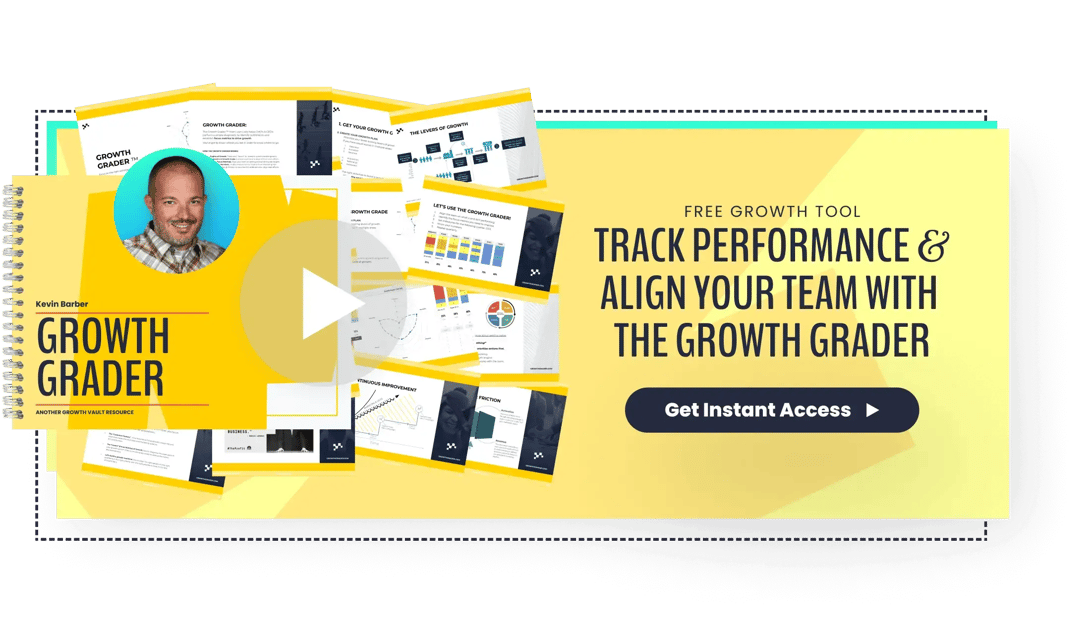Every piece of content you produce is a chance to talk to your customers.
In today's world, the buyer has all the power. They don't want to be disrupted by messages that aren't relevant. They want to be engaged naturally and organically. Then they want to weigh up their options and make an informed decision.
Sounds like a tall order, doesn't it? It doesn't have to be. But you will face challenges.
Content marketing has the power to build brand awareness, increase conversions, and establish your business as an authority in your industry. Don't let these challenges stop you.
We'll show you how to overcome them and make content marketing the cornerstone of growth in your company.
VIDEO TRAINING
Get The Growth Marketing Playbook.
Learn to plan, budget, and accelerate growth with our exclusive video series. You’ll discover:
- The 5 phases of profitable growth
- 12 core assets all high-growth companies have
- Difference between mediocre marketing and meteoric campaigns
Thanks for submitting the form!
We'll review the information you've submitted and respond to you just as soon as possible.
Content Marketing for Business Growth
Storytelling, being genuinely helpful, answering questions, and giving out free information. These practices all fall under the same umbrella: content marketing. As part of an inbound marketing strategy, you create something your audience seeks out instead of forcing them to read, watch, or listen to content they're not interested in.
According to HubSpot, 'content marketing is the process of planning, creating, distributing, sharing, and publishing content via channels such as social media, blogs, websites, podcasts, apps, press releases, print publications, and more. The goal is to reach your target audience and increase brand awareness, sales, engagement, and loyalty.'
It sounds like a pretty simple statement, but a ton of planning and execution goes into content marketing, especially if you want to get it right and drive growth in your business.
Content marketing done well has the power to educate your prospects on your solutions and build a relationship with your customers from the first interaction through to a glowing testimonial.
If you don't produce quality content regularly throughout the buyer journey, you risk failing to resonate with your audience and relying on paid ads and promotions to bring in leads. It's a wasted opportunity.
Often, companies don't produce content because they're paralyzed by the challenges we'll outline today. Let's dig deeper.
1. Understanding Buyer Personas
Challenge
If you don't know your buyer persona(s), you'll produce content for everybody instead of somebody.
It might not seem like a huge deal, but you're not trying to sell to everybody. Your service or product solves a problem for a specific audience. If you don't know your audience, your content will fall flat or be drowned out by more prominent players in your market.
Imagine you're selling burgers. Trying to reach every person that likes burgers is a lousy play. But if your sole product is a quality, carb-free, high-protein, meatless burger, you can create content that speaks to a specific audience of vegan burger lovers.
Of course, you don't always need to drill down to a tiny niche, that's a problem in itself, but you need to know who you're creating content for.
Solution
Before you create any content:
- Decide who it's for and what value it provides for them.
- Create a buyer persona or a couple of personas.
- Construct each persona and list their characteristics, quirks, worldview, and aspects of their personality in one document.
Your persona should feel like a real person. For example, Vegan Vince is an avid bodybuilder who misses burgers but hasn't found a suitable replacement yet. He doesn't want processed soy; he wants something quality and tasty.
Your website is your best salesman. Every piece of content Vince consumes from your company should speak to his worldview and entice him to want to learn more about your product and how it aligns with his lifestyle.
Related: Buyer Personas: What Are They And Best Practices
2. Consistently Producing Content
Challenge
One of the most common reasons for not producing content is the perceived notion that it's too much work to create and publish content regularly. But for your content to have an impact, you need a library of relevant and valuable content that positions you as an expert in your field.
Without a strategy and schedule, you risk becoming lax; you might fall into the trap of posting only when you feel like it. You'll also scrape around for something interesting to post about.
Solution
You need a documented strategy and schedule. It's like going to the gym. You know when you're going to go, you put it on your calendar, and if you're savvy, you know the workout you're going to do. If it's not on your calendar, you probably won't go.
Having a clear strategy and schedule helps prioritize content creation. Monitor your competitors. How much content do they put out? You'll have a benchmark of how consistent the competitors in your market are.
Plan the content schedule for each quarter. Will you post once a week? Twice? It depends on your capacity. What can your team handle? Remember to balance quantity with quality.
If you decide to produce more content, you need to manage it well. It's best to manage content in one system. Without a content management process, organizational silos appear, and content quality and consistency might be affected. Ensure articles are peer-reviewed, organized well, and labeled effectively.
3. Producing Relevant and Useful Content
Challenge
High-quality content isn't just about getting the SEO piece right (although that's super important for Google rankings). More important is that your articles are relevant and useful to the topic you're writing about and to your desired audience.
You'll lose a prospect's attention in a matter of seconds if you shove content in front of them that doesn't resonate.
Equally challenging is writing original content. When we say “original content,” we don’t mean content no one has done before. Maybe five competitors have already blogged about the same topic; the challenge is doing it better. What did your competitor miss? Could you come at the topic from a different angle? Is your solution different?
Solution
Be bold. Have an opinion. Customers align themselves with strong views, especially when they share the same thoughts as you. One-size fits all content is safe. It's content for the sake of content.
Find a unique angle and share it with your audience. Most importantly, answer the questions that your ideal customers are asking. Content that speaks to your ideal customers starts a relationship, positions you as an authority, and builds trust.
To influence your prospect's purchasing decision, thoroughly research your content, ensure you're up to date in your field and provide valuable and relevant content.
4. Buyer Journey Alignment
Challenge
Buyers have all the power. If a piece of content doesn't immediately pique their interest or provide a solution to their problem, they'll move on to the next article or website.
Along the buying process, you need your prospects to see relevant content at the right time and on the correct medium. Buyers have an appetite for information and want to weigh their options before even talking to a supplier. How can you ensure your content meets them where they are?
Without a strategy that includes the buyer journey, you'll miss opportunities to engage with buyers and meet them where they are.
Solution
Create content for each stage of the buyer journey. What does that look like?
In the awareness stage, speak to your buyer's symptoms, problems, and challenges. Can you help them identify their problem and then provide helpful content? Empathy helps build trust.
In the consideration stage, educate buyers on solutions. Further educate them and highlight solutions. Send them to useful webinars or live trainings if you communicate with them over email.
In the decision stage, it's time to highlight the value of your solution and convince prospects to choose your solution. Provide examples of where you've gone above and beyond for your customers and use cases and testimonials.
Don't forget about existing customers! They want to consume relevant content too. Content that drives action and features compelling CTAs, distributed on the proper channels, is a potential goldmine.
Related: How To Create A Lead Magnet Or Content Offer For Every Buyer Journey Stage
5. Battling Against Paid Promotion
Challenge
Paid ads and promotions often reach the top of search engines. Platforms like Twitter, Facebook, and Linkedin offer various ways to segment audiences and reach customers with paid promotions and ads.
If you're not paying to promote your content, are you losing? No, but it's no use trying to match competitors who plow the bulk of their marketing dollars into social media ads. Organic social promotion that promotes your blogs, podcasts, and website content still has its place.
Equally, content isn't just for social media. What if your clients don't hang out on social media sites? Email, your website, and Google are still crucial spaces for content to live.
Solution
Use paid promotions wisely. Set a budget, nail target demographics, and share the correct type of content for your desired audience. It's important to experiment, but experiments shouldn't break the bank.
Related: Content Promotion Strategies That Move The Needle (Paid And Earned)
Set goals, experiment, learn, and either double-down or pivot. Your goal might be more website traffic. How will you measure that? Do you have the systems in place? Strategy and schedule play important roles here. Maybe you'll promote one piece of content out of every five. Track metrics carefully and decide whether the investment is worth it.
Also, remember that valuable and relevant content is evergreen. Paid promotions are fleeting.
6. ROI and Stakeholder Buy-in
Challenge
How well is your content performing? If you don't measure and analyze content performance, you won't convince stakeholders to invest in content production or be able to show a marketing return on investment (ROI).
It's challenging to tie content to conversions and evaluate the impact content marketing has on your business. But not impossible. There isn't a perfect model. But if a potential customer clicks on the CTA at the bottom of your blog article, you at least know that they're consuming the content and taking action.
Stakeholders don't want to plow money into campaigns continually. Big-budget campaigns might provide ROI, but is it the right type? You might drive traffic to your site, but is it the right traffic?
Solution
Set key performance indicators (KPIs), objectives, and goals. If you want buy-in from stakeholders, have a clear plan or strategy and know which metrics you want to measure.
For example, for a blog article, you'll need to measure traffic flow, backlinks, internal links, CTA performance, domain authority, and shares. Platforms like HubSpot manage content and provide reports, so you can track performance easily and show the effectiveness of your content.
With end-to-end tracking of customers from their first visit to a sale, you'll know the role content plays in the buyer journey and prove ROI to stakeholders.
Content Marketing for Business Growth: It Starts With a Plan
It's a big mistake to rush to market without a plan for each part of your business, including marketing. You need a strategy, and content marketing plays a significant role.
Challenges can be overcome with alignment, robust planning, and organization. Be customer-centric, and produce content with the buyer ALWAYS in mind. It might seem overwhelming to collect, store, and curate content, but with platforms like HubSpot, you can have all your data in one place.
We use Hubspot with all of our clients to make the most out of data and provide personalized experiences for your customers. To see how content marketing fits into the growth marketing playbook, book your Growth Mapping session today!







